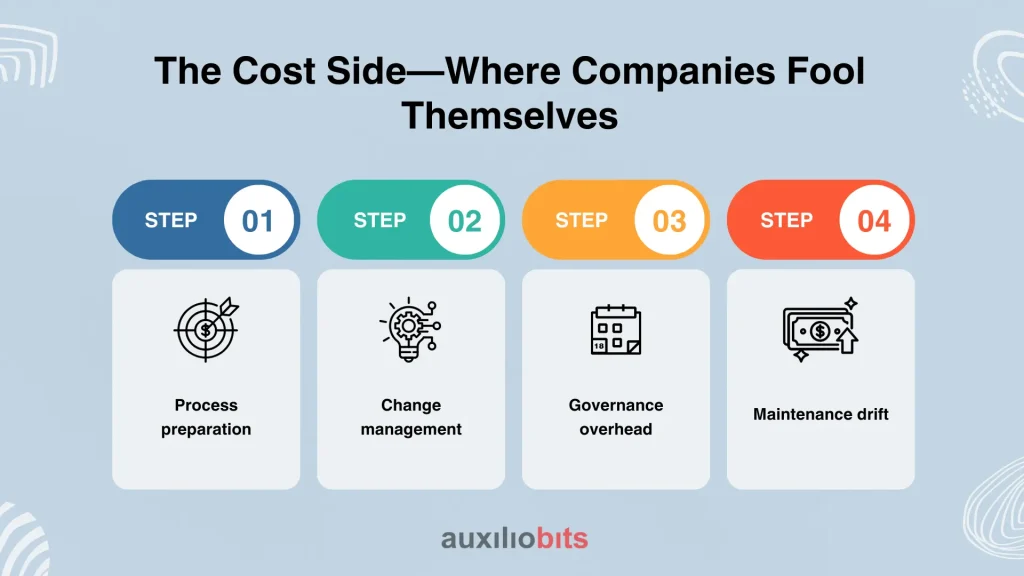
Key Takeaways
- ROI slides oversimplify; frameworks must include messy costs and subtle benefits.
- True benefits extend beyond payroll: resilience, compliance assurance, and customer loyalty.
- Multi-year horizons are essential—APA looks expensive at first, but rewarding later.
- Sensitivity analysis prevents over-optimism.
- Trust in the numbers, not just the numbers themselves, drives executive buy-in.
Walk into any boardroom discussing automation and you’ll hear the same questions repeated in different accents: “What’s the payback? How fast? How sure are we?” Everyone nods when the CFO asks about ROI, but the truth is more awkward—most automation projects don’t track costs and benefits rigorously enough.
Robotic Process Automation (RPA) promised rapid efficiency by mimicking routine human actions. It worked in many cases: data entry, reconciliations, and claims processing. Then came Agentic Process Automation (APA), a more ambitious layer where AI agents don’t just click and type but interpret, decide, and adapt.
Sounds promising. But is it worth it? That depends on whether an enterprise evaluates the full picture—something a superficial ROI percentage can’t do.
Also read: Enhancing Enterprise Agility with RPA Automation in AI-driven Business Architectures
Why the “ROI Slide” Is Dangerous
Executives love a clean graph. “Payback in 12 months.” “200% ROI.” Yet every automation practitioner knows those numbers often age poorly.
Take an insurance company that automated claims registration. At first glance, 20 FTEs were “saved.” Look deeper:
- Twelve of those FTEs were redeployed, not eliminated.
- Exception handling created an extra manual queue.
- Bot upkeep doubled once the claims platform updated.
Did the project fail? Not really. Call-center agents reported higher morale, customers got quicker responses, and compliance errors fell. But the glossy ROI deck didn’t reflect the messy reality.
That’s why a framework—not a vanity slide—is necessary. It disciplines both cost estimates and benefit assumptions, and it forces organizations to admit that benefits show up in unusual places.
What a Real Framework Needs to Capture
Automation initiatives live or die by nuance. Treat every project as if it were just “cost of software versus labor saved,” and you’ll kill good ideas or oversell bad ones.
The Cost Side—Where Companies Fool Themselves

- Process preparation: Before RPA, you clean workflows; before APA, you scrub data. This can swallow 25–40% of a project’s budget. Rarely accounted for.
- Change management: People resist. Training manuals need rewriting. SOPs need revising. One pharma company spent more on retraining than on building bots.
- Governance overhead: APA in particular requires auditability, validation, and monitoring. Regulators won’t care that the bot “mostly works.”
- Maintenance drift: RPA bots break with UI tweaks; APA agents degrade as models lose relevance. Ongoing support isn’t optional.
Too many business cases bury these under “contingency.” That’s not realism; that’s wishful thinking.
The Benefit Side—More Than Payroll
Yes, labor substitution is measurable. But in practice:
- Cycle-time improvements free up working capital or speed service.
- Error reduction avoids rework or fines. A healthcare firm cut billing errors by 38%—worth more than staff savings.
- Scalability means absorbing seasonal volume without hiring temps.
- Employee experience improves when repetitive tasks vanish. Staff retention follows.
- Decision quality (APA): An AI agent catching supplier risk early is more valuable than shaving minutes off invoice entry
Time Horizon—The Silent Killer of ROI
RPA looks attractive because year-one savings show up fast. By year three, support costs creep up. APA, by contrast, looks expensive upfront—data lakes, orchestration platforms, compliance checks—but pays off later. A three-year view punishes APA unfairly. A five-year model, with discounted cash flows, is more honest.
A Practical Scaffold for Cost-Benefit Analysis
How to actually structure this? A scaffold helps avoid bias.
Step 1. Scope clearly
- Define process boundaries.
- Document the “as-is” baseline.
Step 2. Capture costs in buckets
- Direct: licenses, infrastructure, API usage.
- Indirect: integration, discovery, governance, and change management.
- Recurring: monitoring, retraining, patching.
Step 3. Identify benefits honestly
- Hard: labor hours avoided, overtime cut.
- Soft: fewer errors, SLA adherence, and improved compliance posture.
- Strategic: customer retention, scalability, and foresight.
Step 4. Monetize with proxies
Not everything has a neat dollar value. Estimate anyway:
- Reduced attrition → avoided recruitment cost.
- NPS uplift → modeled revenue from repeat customers.
- Fewer compliance breaches → avoided penalties.
Step 5. Run scenarios
- What if exception rates stay stubbornly high?
- What if retraining costs spike?
- What if a regulator introduces new audit rules?
Step 6. Present for different audiences
- CFO: payback period.
- COO: throughput impact.
- CIO: maintenance load.
The same analysis must be reframed depending on who reads it. Otherwise, the numbers won’t persuade.
Two Contrasting Stories
Insurance RPA pilot: Bots handled policy issuance. Payback appeared within 14 months. But system changes forced rework, eating 40% of projected savings. Net outcome? Still positive—customer SLA times improved by 30%—but the CBA had to be rewritten three times because initial assumptions were naive.
Logistics APA project: Agents predicted shipment delays and auto-notified clients. The first-year business case looked awful—investment in data pipelines, orchestration, and governance delayed returns. By year three, churn dropped 12%, a benefit nobody had priced in. The CFO later admitted: “If we had judged this like an RPA pilot, we would have killed it too soon.”
Common Pitfalls That Skew the Math
- Overstating headcount reduction: Layoffs rarely align neatly with automation. Redeployment dominates.
- Undervaluing compliance: A single avoided fine can outweigh years of payroll savings. Yet it’s often ignored.
- Forgetting morale: Work quality matters. Staff who escape tedious copy-paste stay longer. That retention translates to money.
- Applying RPA math to APA: Adaptive agents have compounding benefits and evolving risks. Treating them like bots misjudges value.
Why the Framework Is Political, Not Just Technical
Here’s the uncomfortable truth: cost-benefit frameworks are less about numbers and more about credibility.
A shallow spreadsheet erodes trust. One banking executive told me, “I didn’t doubt the bots. I doubted the report. It was too pretty, too simplistic.”
Decision-makers interpret CBAs through their own priorities. The COO cares about cycle time, not discount rates. The CIO obsesses over integration risk. The CFO zeros in on cash flows. If your framework doesn’t anticipate these perspectives, it fails—even if the math is right.
Pulling the Threads Together
Automation isn’t about whether robots or agents are clever; it’s about whether they change the economics of running a business. Cost-benefit analysis is the lens through which enterprises decide. Get it wrong, and promising projects die. Get it right, and skeptical executives will back transformative bets.
RPA offers quick relief but plateaus. APA takes longer to mature but unlocks strategic resilience. Both deserve disciplined evaluation. Ignore governance, and you’ll underestimate cost. Ignore strategic benefits, and you’ll underestimate value. Focus only on year one, and you’ll make short-term decisions that age badly.
A strong cost-benefit framework is less an accounting tool than a narrative device: a way to tell a believable, nuanced story of why automation is worth it—or why it isn’t.
Conclusion
A cost-benefit analysis for RPA or APA is not a spreadsheet exercise—it’s a mirror. It reflects how clearly an organization understands its processes, how honestly it values time, and how willing leadership is to own trade-offs that rarely fit into neat financial cells. Numbers help, but context decides. A “cheap” bot can be ruinously expensive if it locks a team into brittle workflows; an “overpriced” agentic pilot can prove invaluable if it unlocks flexibility no one had priced in.
If there’s one thing experience has taught me, it’s that frameworks are only as strong as the conversations they provoke. The most accurate analysis means little if decision-makers still chase vanity metrics or hide true costs. On the other hand, even an imperfect model can spark the kind of candid debates—about capacity, risk appetite, and strategic intent—that make automation worth the investment.
So the point isn’t to create a perfect framework. The point is to create one that your stakeholders trust enough to use. When that happens, RPA and APA stop being buzzwords or line items; they become strategic levers. And that’s when the math finally starts to matter.








